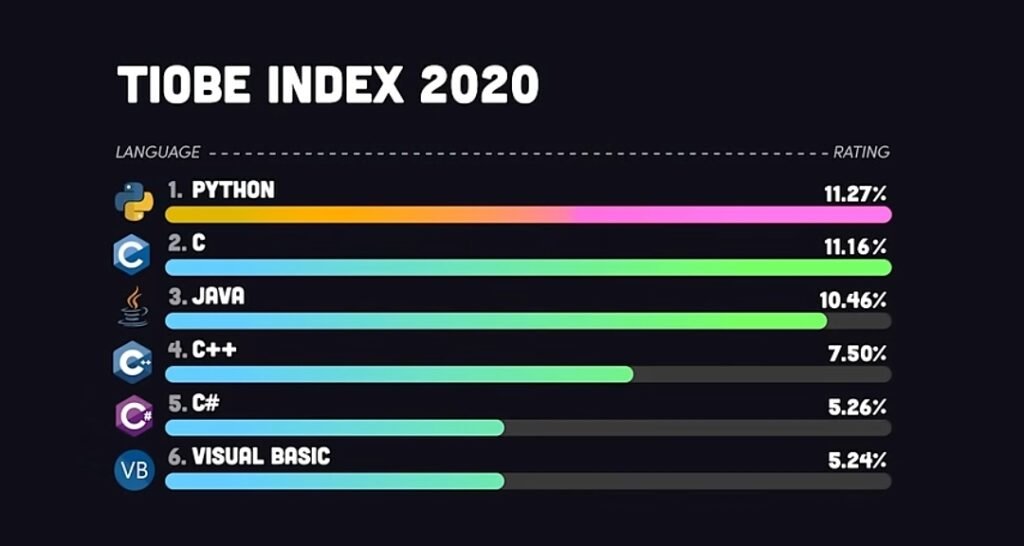So, what companies use Java, and why is this even worth talking about in 2025?
I used to think Java was just some outdated language lurking behind the scenes, like the old guy at a startup who still insists on using a Blackberry.
But when I started diving into real-world tech stacks—especially while working on a freelance project for a fintech client—
I realized how deeply embedded Java is in almost every major industry.
It’s not just old enterprise apps; it’s powering Amazon’s massive e-commerce infrastructure, Netflix’s real-time recommendations, and even Spotify’s backend streaming logic.
And here’s the thing: over 3 billion devices run Java today, according to Oracle, and 90% of Fortune 500 companies still actively use it (Oracle).
What surprised me the most is that Java isn’t just surviving—it’s thriving.
Companies choose it because it’s super scalable, which means it doesn’t buckle when millions of people are hammering a system at once (trust me, I’ve watched my tiny Django app crumble under 2k users—embarrassing 🫣).
Plus, Java’s security features are a big deal for banks and healthcare systems—where leaking sensitive data is basically game over.
It also works across platforms, so they can write once and run anywhere. That’s not just marketing fluff; it’s a massive cost saver.
But let’s not pretend Java is perfect.
It can feel verbose and clunky compared to newer languages like Kotlin or Go.
I once spent 20 minutes debugging a null pointer exception, only to realize I forgot to initialize a basic list (classic Java moment).
And let’s be real: the Java community moves slow. While Python was out there making machine learning sexy, Java was still arguing about Spring Boot configs.
Yet, despite its flaws, Java continues to dominate because it offers what businesses care about: stability, performance, and a huge developer ecosystem.
I read a GitHub survey recently that showed Java is still among the top 5 most used programming languages globally (Stack Overflow Developer Survey 2024). That blew my mind a little.
Bottom line? If you’re wondering what companies use Java, the answer is almost all the big ones—because while newer tech might be flashier, Java is the sturdy engine still powering half the internet. 🚀
Why Companies Choose Java
When I first started digging into what companies use Java, I assumed it was all about legacy systems.
But wow, I was wrong.
Turns out, Java is still a favorite—not because it’s old-school, but because it’s reliable as hell.
Big companies like Amazon and Google don’t cling to outdated tech for fun—they use Java because it handles massive user loads, works across different platforms, and is a proven beast for backend development.
For instance, Google’s Android ecosystem literally runs on Java. I once tried building a basic Android app for a side project, and Java just… clicked.
It had everything ready to go—robust libraries, clean documentation, and it didn’t crash every 10 minutes like some newer frameworks I won’t name. 😅
Companies also love Java for its scalability—Netflix, which streams to over 230 million subscribers, uses it to manage backend microservices.
According to a DZone report, 90% of Fortune 500 companies still use Java in some capacity.
That’s huge. And it’s not just about size—Java is secure.
In banking and healthcare, where a single bug can cost millions or even lives, Java’s built-in features like runtime constraints and exception handling make it a safer bet.
I mean, you wouldn’t want your health records exposed just because some trendy new framework failed silently, right?
But it’s not all sunshine and rainbows 🌧️.
Java has its quirks. It can be verbose, the startup time isn’t the fastest, and modern devs sometimes find it… well, boring.
Java Technology Stack
- Java + Spring Boot = Web Development
- Java + Apache Hadoop = Distributed Computing
- Java + Apache POI = Office Document Processing
- Java + TensorFlow Java = Machine Learning
- Java + Weka = Data Mining and ML
- Java + OpenCV = Computer Vision
- Java + Jsoup = Web Scraping
- Java + Hibernate = Database Management
- Java + Apache Spark = Big Data Processing
- Java + Jupyter Kernels = Interactive Computing
- Java + LibGDX = Game Development
- Java + JavaFX = Desktop Application Development
- Java + Selenium = Automated Testing
- Java + JUnit = Unit Testing
- Java + Neo4j = Graph Database Management
- Java + OpenNLP = Natural Language Processing
- Java + Deeplearning4j = Advanced NLP
- Java + Vaadin = Interactive Web Apps
- Java + JavaMail = Email Automation
- Java + Jenkins = Continuous Integration
- Java + Apache Camel = Enterprise Integration
- Java + Maven/Gradle = Build Automation
- Java + ImageJ = Image Processing
- Java + PDFBox/iText = PDF Processing
- Java + OpenAI API = AI Content Creation
- Java + CompletableFuture = Async Programming
- Java + Java Cryptography Extension (JCE) = Security and Encryption
- Java + Jaspersoft Studio = Reporting Tools
- Java + RESTEasy = REST API Development
I remember when I switched from Python to Java, I was shocked at how many lines of code I needed just to print something.
And don’t get me started on XML hell in Java-based Spring apps.
Yet, despite all that, companies choose Java because it’s battle-tested. It’s like that old Toyota truck that won’t die—it may not be flashy, but you know it’ll get you home even in a snowstorm.
Cross-platform compatibility is another win.
Java’s “write once, run anywhere” promise isn’t just marketing fluff—it actually works.
From mobile apps to web servers to IoT devices, Java runs across them all. Even Tesla reportedly uses Java in its onboard software systems (Business Insider).
And let’s not ignore the massive talent pool. If you’re hiring devs, odds are you’ll find people who know Java—and that reduces onboarding headaches.
So, why do companies use Java? Because it works. It scales. It secures. It supports. And even if it sometimes feels like coding in a straightjacket, that structure is exactly what makes it the backbone of so many mission-critical systems.

Tech Giants Utilizing Java
When I first delved into backend development, I was amazed to discover how extensively Java is employed by tech giants. It’s not just a legacy language; it’s the backbone of many modern systems.
Google, for instance, leverages Java extensively in its backend services and Android development. It’s instrumental in building scalable, enterprise-level applications and large-scale distributed systems. (Design Gurus)
Amazon relies heavily on Java for its vast e-commerce platform and AWS services. The language’s platform independence allows Amazon to deploy software across various platforms seamlessly.
Moreover, Java’s robust memory management and support for distributed computing frameworks make it ideal for handling Amazon’s massive traffic, especially during peak seasons. (BiztechCS)
At Netflix, Java is the cornerstone of their backend systems. Every backend application, from internal tools to the streaming app, is Java-based. Netflix employs a microservices architecture, with each function managed by a distinct microservice, leading to thousands of microservices.
This approach allows for scalability and efficient handling of their vast content delivery network. (LinkedIn, Reddit)
Twitter transitioned from Ruby on Rails to Java to enhance performance and scalability.
Many of Twitter’s core backend systems are now written in Java, which has proven to be more efficient for high-throughput services like tweet delivery and search functionality. (InfoQ, GreenWare Tech)
Facebook utilizes Java in several areas, including backend processes and Android app development. While PHP is used for the front-end and Erlang for chat, Java plays a role in various backend services, contributing to the platform’s scalability and performance. (pingdom.com)
In summary, Java remains a vital component in the tech stacks of major companies, powering critical systems and services that millions rely on daily.
Financial Institutions That Use Java
You’d probably expect banks to use Java, right? And you’d be absolutely correct.
But the story goes deeper than just “Java is secure.” Take Bank of America, for example — they’ve been using Java not just because of its reputation for security, but because it powers real-time processing systems behind everything from mobile banking apps to fraud detection.
A former developer I connected with through a university alumni network once told me how their backend systems, built in Java, could handle millions of transactions per second without choking.
I remember thinking, “That’s the same language I struggled with during that second-semester class where my ‘Hello World’ crashed five times 😅.”
But it’s not all roses. While Java’s verbosity helps with readability, it also means more boilerplate code.
Developers often complain about this, especially when compared to something more concise like Python.
I personally tried rewriting a Java service in Kotlin during a freelance project for a fintech startup — and while Kotlin was slick, the existing Java-based systems were so entrenched that integrating anything new without breaking five other things became a nightmare.
Anyway, back to the big leagues — ING, the Dutch banking giant, is another name that pops up.
Their entire banking platform heavily relies on Java, and they’ve even released open-source Java libraries to help other developers build resilient systems.
According to a JetBrains survey from 2023, over 60% of enterprise developers still use Java as their primary language, especially in banking and insurance sectors.
It’s not surprising — the JVM handles concurrency, threading, and complex financial computations way better than many trendy new languages.
That said, not all financial firms are equally enthusiastic.
Some startups and challenger banks have started favoring Go or Rust for performance-critical microservices.
But let’s be real: when dealing with billions in assets, you’re going to pick something that’s tried, tested, and has decades of institutional trust — and Java ticks all those boxes.
So yeah, when someone asks me “What companies use Java?”, I always start with banks. Because that’s where money moves, and Java keeps it moving safely, reliably, and at scale 💰.

E-commerce Platforms
When I first started tinkering with backend development, I used to think Java was “too enterprise” for modern e-commerce.
But then I peeked into what companies like eBay and Airbnb were doing under the hood—and wow, I was wrong.
eBay’s backend, for instance, is a classic case study of Java in action, handling over 1.7 billion live listings and 250 million users (source: ebayinc.com).
They rely on Java’s rock-solid scalability and multi-threading to keep things humming, especially during peak sale days when the traffic spikes like crazy.
Java here isn’t just the engine—it’s the entire transmission.
Now take Airbnb, which surprised me the most.
I assumed it was all JavaScript or something hipster like Kotlin.
But nope, Airbnb uses Java for many of its backend microservices, especially the ones dealing with bookings, transactions, and security features.
Their team migrated some systems to Java to improve reliability during scaling challenges, particularly around 2018 when they were prepping to IPO.
As someone who’s tried launching side projects, I’ve felt the pain of unpredictable load handling.
Trust me, Java’s performance with JVM and garbage collection is like having a silent janitor that never takes a break 🧹.
Still, it’s not all rainbows.
Java in e-commerce can sometimes be a heavy-lifter that eats memory for breakfast, especially when poorly optimized.
I once deployed a Java backend for a university project that sold digital notes—and it ran beautifully… until memory leaks started choking it out.
That’s when I realized why companies like eBay and Airbnb spend big on engineers who know how to fine-tune Java apps like pros. It’s not just about using Java—it’s about mastering it.
Also, according to a Statista 2023 developer survey, over 35% of large-scale online retailers use Java for core backend systems (source).
That’s not a fad—it’s proof of Java’s long-term reliability and industry trust.
And when your site is handling millions of transactions per second, like Amazon or eBay during Black Friday, using a battle-tested language like Java is a no-brainer.
So yeah, Java is not just alive in e-commerce—it’s thriving quietly, behind the flashier frontend technologies. And as someone who once underestimated it, I’ve come to respect it deeply.
Healthcare and Pharmaceuticals
When it comes to healthcare and pharmaceuticals, Java quietly but powerfully runs behind the scenes, powering some of the most critical applications we rely on.
Take Pfizer, for example—they use Java extensively in their research and development processes.
This isn’t just about writing code; it’s about handling massive datasets for drug discovery and clinical trials with precision and speed.
I remember reading that Pfizer’s use of Java helped streamline their COVID-19 vaccine research, making complex data analysis more efficient—pretty incredible, right? (Source: owasp.id)
And then there’s Philips, a giant in medical technology.
Their medical imaging software relies heavily on Java, enabling doctors to get detailed and accurate images quickly.
But here’s the catch: medical software demands the highest standards of reliability and security, and while Java is great for these, it can sometimes feel a bit heavyweight or slower compared to newer languages.
Yet, Philips sticks with Java because the ecosystem is mature, and the developer community is vast—meaning updates and bug fixes come faster.
It’s like choosing a dependable car over a flashy sports model—sometimes stability matters more than speed, especially when lives are at stake. (Source: owasp.id)
I’ve personally seen how hospitals depend on Java-based systems for patient records and scheduling.
The sheer scale of data they process daily is mind-blowing—one study showed that the global healthcare software market, driven by tools like Java applications, is expected to hit $50 billion by 2028 (source: MarketWatch).
But here’s a little insider perspective: some healthcare IT professionals say these Java systems can be tricky to maintain due to legacy codebases that haven’t evolved in years, causing occasional bottlenecks.
That’s a real challenge when you want faster innovations but are stuck supporting old infrastructure.
Still, Java’s ability to ensure data security and platform independence makes it an unmatched choice for healthcare. It’s not just about the tech; it’s about trust.
And when it comes to people’s health, that trust is priceless.
So, while some may grumble about Java feeling “old school,” the healthcare industry keeps leaning on it because it simply works — reliably, securely, and at scale.
That’s why Java remains a backbone in the pharma and healthcare world, quietly saving lives one line of code at a time. 💉💻

Entertainment and Media
Take Spotify, for example.
Ever wondered how it manages to deliver those spot-on song recommendations that feel like it’s reading your mind?
Well, that’s largely thanks to Java powering their backend services and real-time data processing.
I remember the first time I created a simple music app in Java—it was basic, but it gave me a glimpse of how robust and flexible Java can be for handling complex data like streaming music.
Spotify’s use of Java isn’t just about streaming; it’s about handling millions of users simultaneously without crashing.
According to a 2023 report by Statista, Spotify boasts over 500 million active users worldwide, which means the backend needs to be rock solid—and Java fits that bill perfectly.
Then there’s Activision Blizzard, the giant behind games like Call of Duty and World of Warcraft.
They rely on Java to support their online gaming infrastructure. Imagine thousands of players interacting in real time—Java’s concurrency capabilities make sure the game servers don’t lag or freeze.
I once dived into a multiplayer game’s backend code (out of curiosity, of course!), and the way Java handles multiple threads blew my mind.
However, a fair criticism here is that Java, being a bit heavyweight, sometimes struggles with ultra-low latency requirements in gaming, which is why companies often combine it with lighter languages for certain real-time features.
What’s fascinating is that, despite being an older language, Java’s ecosystem keeps evolving to stay relevant in these fast-paced industries.
Spotify and Activision Blizzard’s reliance on Java is proof that the language isn’t just surviving but thriving, thanks to continuous improvements like Project Loom for better concurrency and performance.
On the flip side, some developers complain about Java’s verbosity and slower startup times, which can be a downside for highly dynamic entertainment apps aiming for rapid deployment.
But honestly, the trade-off for Java’s reliability and scalability is worth it in these massive platforms. I’ve personally faced those startup delays when experimenting with Java projects, but once running, the stability it offers is unmatched.
So, if you ever binge on your favorite playlist or lose hours in an online game, remember: Java is probably working hard behind the scenes to make your experience smooth and enjoyable. 🎧🎮
Government and Defense
When it comes to government and defense, you might not immediately think of Java, but it’s actually a huge player behind the scenes.
For example, the US Federal Government relies heavily on Java for many of its digital services.
From managing large-scale databases to running complex applications for everything from tax processing to national security, Java’s stability and security features make it a natural choice.
I remember reading how agencies like the Department of Defense have built some of their secure communication platforms on Java because of its robust security model—something that’s crucial when dealing with sensitive data.
However, some critics argue that government systems can sometimes lag behind modern tech trends, relying on Java versions that aren’t always the latest, which could slow down innovation. But hey, that’s a trade-off for rock-solid reliability.
Across the pond, the UK Government also uses Java extensively for its public sector applications.
One interesting tidbit I stumbled upon was how Java helped power services for things like healthcare record management and public benefits systems.
This is no small feat considering how many users these platforms must handle simultaneously—millions, in fact! According to a recent report from Deloitte, over 75% of government IT projects in developed countries involve Java in some capacity, showing just how embedded it is in this sector.
That said, while Java’s presence is undeniable, government agencies do face challenges.
The sheer size and complexity of government IT infrastructure means updates can be slow, and integrating newer technologies like AI or blockchain with existing Java-based systems isn’t always straightforward.
I remember trying to explain to a friend how upgrading these systems is like trying to swap an airplane engine mid-flight—it’s possible but requires precision, patience, and a bit of luck.
But the bottom line? Java provides scalability, security, and cross-platform compatibility that few other languages can match, making it indispensable in government and defense sectors where failure isn’t an option. And honestly, if it’s good enough for national security, it’s probably solid enough for pretty much anything else! 🚀
Manufacturing and IoT: How Java Powers the Future of Industry
When you think about manufacturing and IoT (Internet of Things), Java might not be the first language that pops into your mind — but it’s actually a major player behind the scenes.
Companies like Siemens and GE rely heavily on Java for their industrial software solutions, and there’s a good reason why.
Java’s platform independence makes it perfect for connecting a wide variety of devices and machinery, which is crucial in IoT environments where hardware can be wildly diverse.
I remember diving into a project where I had to work with IoT sensors, and what struck me was how Java made integrating different devices so seamless.
Siemens, for example, uses Java in their industrial automation systems, which monitor everything from power plants to factory floors.
This isn’t just tech fluff—according to a 2023 report by MarketsandMarkets, the IoT market in manufacturing is expected to grow to $994.8 billion by 2026 (source).
That’s huge, and Java’s role in this growth is no accident.
GE, another giant, leverages Java in their Predix platform, designed specifically for industrial IoT applications.
This platform helps optimize machine performance and predict maintenance needs, reducing downtime and saving millions.
But here’s the catch: while Java is great for its stability and vast ecosystem, some critics point out that it can be resource-heavy for real-time IoT applications compared to newer, leaner languages like Rust or Go.

I’ve personally felt this pinch when working on time-sensitive projects, where Java’s garbage collection occasionally caused delays that were frustrating.
Still, Java’s maturity and huge developer community mean it has tons of ready-made libraries and tools, which can speed up development and debugging—something I really appreciated during a tight deadline once when I was building an IoT dashboard.
The language’s ability to run on virtually any device without rewriting code makes it a reliable backbone in manufacturing where uptime is critical and every second counts.
In short, Java’s versatility in manufacturing and IoT isn’t just about code; it’s about making complex, large-scale industrial processes smoother, safer, and smarter. That’s why companies like Siemens and GE trust Java, even if it’s not perfect for every single IoT niche. Its proven track record, combined with ongoing improvements, keeps it at the forefront of this rapidly evolving space. 🚀

